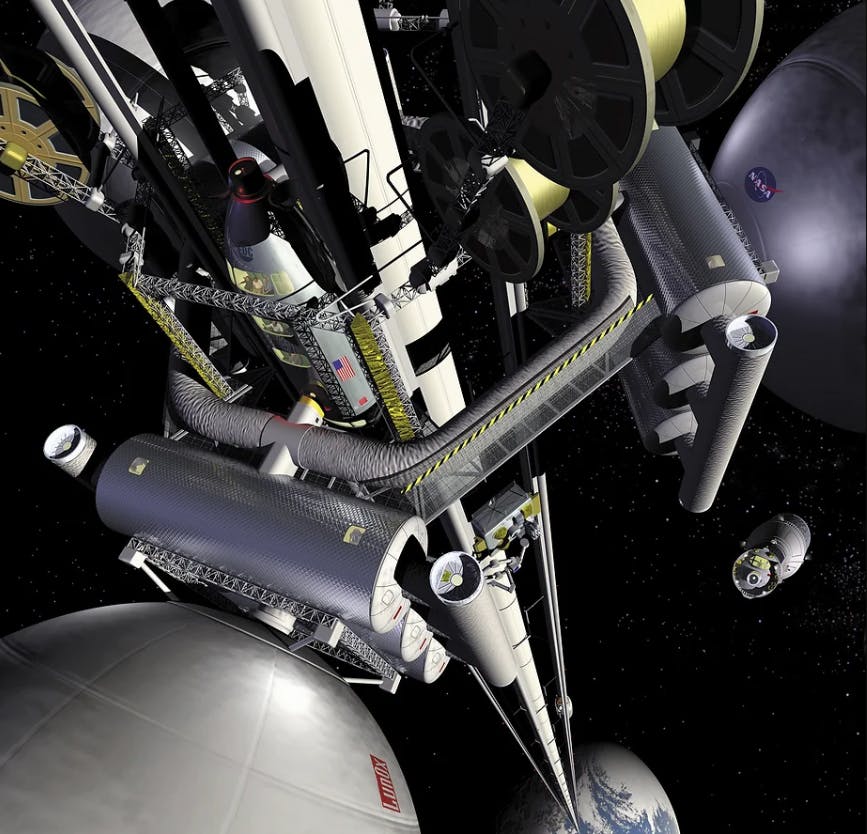The space elevator is not just a fantastic idea but one of the most innovative and bold concepts that can change the approach to space exploration. This idea first appeared more than a century ago and, at that time, was so far from reality that it was perceived more as science fiction. However, with the development of technology and materials science, the space elevator is turning from an abstract dream into an object of real research and development.
The basic idea of a space elevator is to create a permanent physical connection between Earth and space, which would allow cargo and people to be delivered to orbit without the use of traditional rockets. This could significantly reduce the cost and risks of space missions and open up new horizons for commercial space and scientific research.
Today, space agencies such as NASA, the European Space Agency (ESA), and private companies are actively exploring the possibility of implementing this project. The main technical challenges include creating materials that can withstand enormous loads, the necessary energy infrastructure, and ensuring the stability of the elevator in the face of space dynamics. Despite these difficulties, modern scientific research and technological advances give hope that a space elevator could become a reality in the coming decades.
The idea of a space elevator: from science fiction to research
The concept of a space elevator dates back to the nineteenth century when Konstantin Tsiolkovsky (1857-1935) first described the idea of a structure that would connect the Earth to space in 1895. He proposed to build a “sky tower” that would connect the Earth to the geostationary orbit, approximately 35,786 kilometers above the planet’s surface. At the time, this idea was so bold and incredible that it seemed like pure science fiction, but Tsiolkovsky was one of the first to scientifically substantiate the possibility of space travel.
However, the idea of a space elevator became widely known thanks to the famous works of Arthur C. Clarke. In his science fiction novel The Fountains of Paradise (1979), Clarke described a detailed concept of an elevator that would deliver people and cargo to orbit without the use of rockets. This work not only made the idea of a space elevator known to a wide audience but also became an inspiration for many scientists and engineers who began to seriously consider its realization.
In the mid-20th century, thanks to scientific breakthroughs in rocketry and materials science, the idea of a space elevator began to gradually move from science fiction to scientific research. One of the key moments in this development was the study of materials that could withstand enormous loads. At that time, engineers and scientists realized that to create such an elevator, it was necessary to develop an extremely strong and lightweight material that could withstand the loads from Earth’s gravity to outer space.
One of the key challenges was the height of the structure, as the geostationary orbit is more than 35,000 kilometers from the Earth’s surface. However, theoretical calculations showed that such a structure could provide a stable transportation link between the planet and space if the cable material was ultra-strong and ultra-light.
In the second half of the 20th century, several researchers began to actively develop the concept of a space elevator. One of them was the American engineer Jerome Pearson, who in 1975 published the first scientific studies confirming the possibility of creating such a structure. Pearson proposed a detailed plan for the construction of an elevator using the latest technology at the time.
As interest in this topic grew, research began to cover the issue of materials. Modern materials, such as carbon nanotubes and graphene, are considered potentially suitable for creating ultra-strong cables that can withstand loads of this magnitude. Nanotechnology has become a key area that promises to make the space elevator a reality.
In addition to science fiction and theoretical calculations, research by NASA and other space agencies fueled interest in the space elevator at the beginning of the 21st century. NASA organized several competitions to develop technologies for the space elevator, including the creation of robotic platforms that could move along the cable and research into materials for cable construction.
Thus, the space elevator concept has come a long way from science fiction to real scientific research. Ideas that seemed unbelievable more than 100 years ago are now being discussed in serious scientific circles, and although engineers face many challenges, a space elevator could be the next step in space tech.
Technical challenges: what materials and technologies are needed for construction?
The construction of a space elevator remains one of the most ambitious engineering tasks in human history. The biggest challenge is to create a strong cable to withstand the enormous load from Earth to geostationary orbit at an altitude of approximately 35,786 km. This cable must be strong and ultra-lightweight to reduce structural stress and resist space conditions such as radiation, micrometeorites, and temperature extremes.
Selection of cable material
The main technical obstacle is the lack of a material that meets all the requirements for building such a cable. Steel, aluminum, and other traditional materials are too heavy and not strong enough for such distances. However, modern research has revealed new promising materials such as carbon nanotubes and graphene.
Carbon nanotubes
This is one of the strongest materials known today, which can have sufficient tensile strength to withstand a huge load. They have a unique structure composed of carbon atoms that form tubes with extremely high strength with minimal weight. The problem is that, at the moment, there is no technology for mass production of nanotubes of the required length (several tens of thousands of kilometers).
Graphene
This is another high-potential material. Graphene is composed of a single layer of carbon atoms and demonstrates impressive strength and flexibility. It also has a number of other useful properties, such as high conductivity, which can help in the transmission of energy through a cable. However, as with nanotubes, large-scale graphene production with the desired characteristics is still at an early stage of development.
Stability of the structure
A space elevator would be vulnerable to many factors, including winds in the lower atmosphere, space conditions, and vibrations due to the Earth’s rotation. One idea for stabilization is to use a counterweight at the end of the cable outside of the geostationary orbit, which will provide tension and stability to the entire structure. However, this poses additional challenges, as the counterweight must be heavy enough to balance the cable, and launching it into space is another challenge.
Protection against space debris and micrometeorites
The space elevator will operate in an environment where space debris and micrometeorites can pose a serious threat. A collision with even a small object at high speed can damage the cable and lead to catastrophic consequences. Therefore, it is necessary to develop systems to monitor and avoid such collisions, including active tracking of object trajectories and automated systems to correct the cable’s position.
One possible solution is to use so-called “smart” materials that can repair minor damage independently. Such materials are currently being actively researched in the field of nanotechnology and can play a key role in preserving the integrity of the cable.
Energy sources
The space elevator must be equipped with efficient energy sources to lift cargo and people along the cable. One possible solution is to use laser energy that will be transmitted to robotic platforms that will move along the cable. Laser technology would allow energy to be transmitted without the use of wires and reduce the need for heavy equipment on the cable itself.
Construction and deployment of the space elevator
The process of building a space elevator will also be extremely complex. One of the proposed ideas involves launching the initial cable into geostationary orbit using rockets, after which the cable would gradually descend to Earth while being attached to a counterweight that would be placed in higher orbits.
Changes in the Earth’s atmosphere, weather conditions, and possible oscillations of the elevator due to the planet’s rotation will also need to be considered. This will require sophisticated stabilization and control systems.
Possible benefits: how will a space elevator change space travel?
The idea of a space elevator opens up a new era in space exploration due to its potential advantages. Unlike traditional rockets, which require significant energy and resources to launch into orbit, a space elevator could be a cheaper, more efficient, and more environmentally friendly alternative. This technological breakthrough has significant economic, scientific, and social potential.
Reduced cost of launches
One of the main advantages of the space elevator is a sharp reduction in the cost of launching cargo and people into orbit. Today, launching cargo into orbit using rockets costs between $10,000 and $20,000 per kilogram. A space elevator would reduce these costs to a few hundred dollars per kilogram, as it does not require constant fuel consumption for each launch. This will open up new opportunities for more frequent and larger launches, which will allow for more active development of the space economy.
Increasing the affordability of space travel
By significantly reducing launch costs, the space elevator will make space more accessible not only to government space agencies but also to private companies, universities, and even individuals. In the future, we can expect space tourism to reach a new level, when travel to orbit will become not a luxury but an affordable reality for a wider population. This will also stimulate scientific research and the development of innovations in space.
Long-term stay in space
The space elevator can become the basis for creating permanent space stations and colonies on the Moon or even on Mars. Thanks to the ability to transport large volumes of cargo into orbit, it will become easier to deliver building materials, equipment, and resources to create such stations. This will allow not only to support human life in space, but also to develop infrastructure for long-term missions.
Environmental alternative
A space elevator is a more environmentally friendly solution compared to rocket launches. Rocket engines emit significant amounts of carbon dioxide and other harmful substances into the atmosphere, while a space elevator can be powered by electricity or solar energy. This will reduce the environmental impact on the planet and make space exploration more sustainable.
Accelerate scientific research
By reducing the cost of launching scientific instruments and materials, the space elevator will stimulate the development of scientific research. In-orbit research missions, zero-gravity experiments, and exploration of distant planets will become much more affordable. This will accelerate discoveries in such fields as astronomy, physics, biology, and materials science.
Logistics support for the development of distant planets
A space elevator could become an important link in the logistics chain for future missions to Mars or other planets in the solar system. Instead of using large and expensive rockets to deliver resources, a space elevator will allow the accumulation and transportation of the necessary materials into orbit, where they can be loaded onto interplanetary ships. This will significantly reduce the cost of interplanetary missions and ensure the sustainability of research on distant planets.
Development of the space industry
The advent of the space elevator will open up opportunities for the development of new industries, such as mining on asteroids or the production of materials in zero gravity. Cheap and regular access to space could spur the emergence of a space industry that could eventually become an important part of the global economy. For example, materials created in zero gravity may have unique properties that cannot be obtained on Earth.
Realspace tech projects: can a space elevator be built in the coming decades?
The idea of a space elevator has long been considered fantastic, but in recent decades, several organizations, including NASA, Japanese companies, and private research groups, have begun to seriously explore the possibility of its implementation. Although a full-fledged space elevator remains far from being implemented, real steps have been taken to bring us closer to this engineering marvel.
NASA and Space Elevator Games
NASA has long supported space elevator research. In 2005, the agency initiated the Space Elevator Games competition as part of its Centennial Challenges program. The goal of the competition was to stimulate the development of technologies needed for a space elevator, such as lifting cables and power sources for robotic elevators. Participants had to create lifts that could move along a vertical cable using laser energy for propulsion. Although none of the participants were completely successful in creating a working system, the competition provided a significant impetus for the development of new technologies and drew attention to the concept of a space elevator.
Japanese projects: Shizuoka University and Obayashi Corporation
Japanese scientists and companies are among the most active researchers in this area. Shizuoka University is actively working on space elevator prototypes and has already conducted several experiments. In 2018, researchers from the university launched a small prototype of a space elevator into orbit using an H-2B rocket. Although this experiment was small in scale, it allowed for important tests in real space conditions, including checking the stability of the lift’s movement along the tether.
The Japanese construction company Obayashi Corporation also announced plans to build a space elevator by 2050. The company has presented a concept for a structure that will reach heights of over 96,000 kilometers using the latest materials, such as carbon nanotubes. Although this plan seems extremely ambitious, Obayashi Corporation is actively researching high-tech materials that could withstand the enormous loads.
LiftPort’s project
The American company LiftPort Group, founded in 2003, is another example of a private initiative in the field of space elevators. The company’s founder, Michael Lane, has announced plans to create an elevator for the Moon first, which is much easier to implement due to lower gravity and the absence of an atmosphere. According to him, such a lunar elevator could be built in the next 8-12 years. LiftPort has already conducted several experiments on Earth, including launching prototype aerial platforms to a height of 2 km. Although the construction of a full-fledged elevator on the Moon is still a long way off, these projects prove that technical progress in this area is real.
New materials: a step towards realization
One of the main technical obstacles to building a space elevator is creating a cable strong enough to withstand the load. Several important steps have been taken in this direction, including the development of carbon nanotubes. Research shows that these nanotubes have the potential to create a super-strong cable that will be hundreds of times stronger than steel and, at the same time, lighter. Although there is no technology yet to produce such cables of the required length, many scientific institutions are actively working on this issue.
Another promising material is graphene, which also has impressive strength and flexibility properties. Graphene production technology is still evolving, but it is already considered one of the key materials for creating a space elevator in the future.
Space energy and robotic systems
Another important component of a space elevator is the energy system for lifting. The use of traditional energy sources is impractical, so researchers are focused on developing energy transfer systems using lasers. This technology will allow energy to be transferred from the Earth to the lifts that will move along the cable without the need for complex and heavy electrical systems on the elevator itself.
Robotic systems will also play an important role in the realization of the space elevator. They must be able to move continuously along the cable, adjusting speed and adapting to conditions at different altitudes, from the Earth’s atmosphere to the vacuum of space. Prototypes of such robots that can move along cables are already being created today, but they will have to be significantly improved for use in space.
Future prospects of a space elevator
Although a full-scale space elevator is still far from being realized, current research and projects demonstrate that it is no longer pure science fiction. Some researchers believe that the first functional space elevator could be built within the next 30-50 years if significant progress is made in materials science and robotics. At the same time, projects are being developed to create a lunar elevator, which could be the first real step towards the development of this technology.
The space elevator remains one of mankind’s most ambitious ideas, but every year, we get closer to its realization thanks to research projects, innovative materials, and technologies.

















